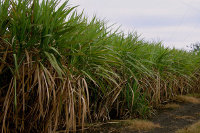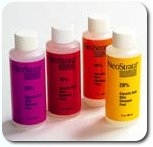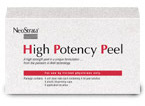lycolic acid
Glycolic acid:
 - main representative of alpha-hydroxy acids,
- main representative of alpha-hydroxy acids,
- in nature it can be found in sugarcane,
- due to its small molecules it rapidly penetrates the epidermis,
- clinical response depends on pH, concentration of free acid in the solution, quantity of the applied preparation, how long the applied peel is kept on the skin and on the condition of the treated skin,
- mechanism of action: reduces cell adhesion in the top layer of the skin, while preserving their structure - this action promotes exfoliation of the outermost layer of the skin without damaging the protective epidermal barrier, moreover, it has antioxidant and moisturising properties;
Indications for glycolic peel:
- symptoms of photoageing,
- juvenile acne (mainly blackheads, papulopustular acne),
- melasma,
- lentignes,
- follicular keratosis,
- after a therapy with local steroids;
The procedure
- there are different concentrations and pH of glycolic acid available: 20%, 35%, 50% i 70%, while pH ranges from 1,6 to 0,6,
- the preparation is applied on the treated skin area with a special brush,
- layers of epidermis are exfoliated,
- the time when the peeling is kept on the skin (usually about 5 minutes) depends on individual skin sensitivity,
- acid neutralisation with a post-peel preparation;
Advantages:
mild, painless, complements oral therapies, improves the quality of the skin, inexpensive.
Disadvantages:
- burning sensation during the procedure,
- the risk of local discolouration in patients with darker skin - it is necessary to apply creams preventing hyperpigmentation,
- the risk of acne-like rash (usually subsides on its own);
Skin care after glycolic acid peel:
- skin flaking starts 2-3 days after the session,
- for about 24-48 hours the skin may stay slightly red and feel very dry and tight, there might appear little scabs,
- there is no downtime (patients may go to work, as usually);
It is recommended to undergo next peel after 10-14 days; to obtain desired effects it is advised to have a series of 6-8 sessions every 10-14 days. The series may be repeated twice a year.
Effects:
- smoothes the skin,
- corrects fine lines,
- reduces the symptoms of actinic (solar) keratosis,
- whitens hyperpigmentation spots;
 NeoStrata peel contains 100% of free glycolic acid to maximise bioavailability; glycolic acid is not neutralized or partly esterified, as these processes would reduce penetration of the acid in the skin. NeoStrata peelings do not contain strontium nitrate which neutralises the feelings like burning or stinging, as any sensations are important regarding safety of the procedure and enable evaluation of the product. NeoStrata Skin Rejuvenation System includes formulations in four different concentrations of glycolic acid: 20%, 35%, 50% and 70%.
NeoStrata peel contains 100% of free glycolic acid to maximise bioavailability; glycolic acid is not neutralized or partly esterified, as these processes would reduce penetration of the acid in the skin. NeoStrata peelings do not contain strontium nitrate which neutralises the feelings like burning or stinging, as any sensations are important regarding safety of the procedure and enable evaluation of the product. NeoStrata Skin Rejuvenation System includes formulations in four different concentrations of glycolic acid: 20%, 35%, 50% and 70%.
High Potency Peel (HPP):
- contains: 70% glycolic acid, 4% acetic acid, 0.5% pyruvic acid, 1.5% ethyl pyruvate, 1% propylene glycol,
- no special skin preparation before the treatment is required (using AHA creams),
- the procedure is the same as during the glycolic acid peel.
Indications for HPP:
- flaccid skin,
- atrophic skin,
- skin ageing,
- brings very good effects on the neck and décolletage,
- rather not suitable for the treatment of acne.
 NeoStrataHigh Potency Peel (HPP) - a new generation of an alpha hydroxy acid - has stronger effect than 70% glycolic acid, as apart from glycollic acid it contains acetic acid and ethyl pyruvate, as well as propylene glycol, which increases penetration of active ingredients. Ethyl pyruvate is an ester of pyruvic acid. Pyruvic acid is a potent alpha-keto acid (AKA), chemically related to lactic acid. It is produced naturally in an organism, as a product of metabolic changes, in which it is transformed into lactic acid. Pyruvic acid is known from its application in dermatology for the treatment of e.g. sebaceous cysts or solar keratosis.
NeoStrataHigh Potency Peel (HPP) - a new generation of an alpha hydroxy acid - has stronger effect than 70% glycolic acid, as apart from glycollic acid it contains acetic acid and ethyl pyruvate, as well as propylene glycol, which increases penetration of active ingredients. Ethyl pyruvate is an ester of pyruvic acid. Pyruvic acid is a potent alpha-keto acid (AKA), chemically related to lactic acid. It is produced naturally in an organism, as a product of metabolic changes, in which it is transformed into lactic acid. Pyruvic acid is known from its application in dermatology for the treatment of e.g. sebaceous cysts or solar keratosis.
Acetic acid occurs naturally in plant and fruit juices. Undiluted, it has a characteristic odour.
High Potency Peel (HPP) is a clinical product used in therapies of hyperkeratotic lesions, pigmentation disorders, superficial scars and changes related to skin ageing.

